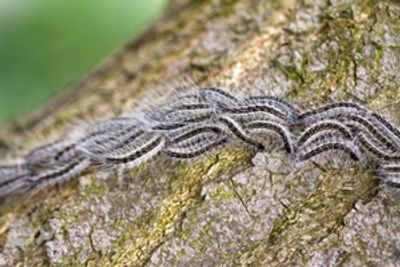
In El Dorado County, oak trees are a part of life. They provide beauty to our environment and much-needed shade during the hot summer months. They also provide an excellent food source for oakworms, sometimes known as leafrollers. These persistent pests can cause extensive damage to your beautiful trees.
In the warmer central valley and foothills of northern California, oakworms (Archips argyrospila) are the most common defoliator of oaks. The adult is a tan-to-gray moth with prominent veins in their wings.
The female lays about 2-3 dozen tiny round eggs on leaves or twigs. The eggs start off as white but become pinkish to brownish-gray prior to hatching. The larvae are about ½ to 3/4 inches in length and are light green with blackheads.
They commonly drop to the ground from oak trees on silken threads, wriggling vigorously when disturbed. Most folks realize they have an oakworm problem when they walk into the silken threads which can become numerous, annoying, and messy.
Young larvae skeletonize the leaf surface, while older larvae chew all the way through the leaf. Defoliation on live oaks may become extensive in May or June and again in July through September. Healthy trees can tolerate some damage; but trees under stress from drought or other factors may decline if defoliated.
The oakworm larvae excrete droppings (frass) that fall to the ground, deck, patio, or pool beneath the tree. As larvae grow, fecal pellets increase in size. Greater numbers of pellets are produced as the number of larvae increases or if the temperature rises, which causes caterpillars to feed faster.
Oaks tolerate feeding by moderate populations of oakworms, and control may not be needed when damage is low. Healthy and well-cared-for oaks can tolerate extensive defoliation without serious harm. If trees need protection from defoliation because they are stressed or of high aesthetic value, spraying of leaves and branches will control oakworm larvae and alleviate the damage they cause, also protecting the health of the tree. Control of the larvae will also reduce the fecal material and webbing that drops from the tree.

Yellow Jackets are one of the flying pests that we deal with on a seasonal basis. They have a very unique life cycle. The queen emerges in early spring, finds a place to nest (usually in the ground), and lays 4-6 eggs. For the first 30 days or so, the queen services the nest. She flies in and out searching for food and pulp to get the nest started. During this time the queen is very vulnerable to predators and severe weather. This provides a perfect opportunity to trap the queen. After the eggs hatch, the queen retires into the nest and by summertime, can produce over 5,000 worker wasps.
The height of their activity is around Labor Day where they can be a real nuisance at a BBQ or picnic table. After Labor Day, the nest starts to die off and about a dozen or so new queens are created. When the first cold spell hits in late October or November, the queens leave the old nest and find a protected area to winter over. The following spring the cycle starts again.
To help minimize the number of Yellow Jackets during the summertime, trapping should be started now. Even if you don’t catch the queens, by catching even a few of the first emerging workers can stress the nest and cause it to be much smaller during the peak of the season.
We recommend the yellow cylindrical “Rescue” traps made by Sterling. The Rescue traps are reusable, but if you are using traps from last year, they should be cleaned first. A stinky, moldy trap can actually repel Yellow Jackets. If the trap is catching flies then it needs to be cleaned or replaced.
The Rescue trap uses a liquid attractant or pheromone to lure wasps into the trap. The liquid attractant can be purchased at most hardware stores and should be used in conjunction with lean meat such as turkey or ham. The meat should be replaced every few days or before it spoils. Tuna, cat food, and other meat can be used but tend to spoil faster and require more frequent replacements. We recommend putting your traps out early. Every queen caught at the beginning of the season will eliminate a potential 5,000 Yellow Jackets later.